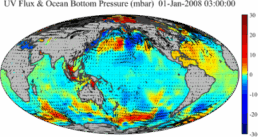Global Flux eXploratory
The CSR Global Flux eXploratory (GFX) is a flexible data and modeling system that supports investigation and application development in global flux studies. It is particularly well suited for developing complex applications that will function in an operational environment and provides a structure with extensive data sets for simpler studies. GFX was used to develop and produce estimates of the non-tidal variability of mass distribution of the atmosphere and ocean and their influence on the Earth’s external gravity field. The resulting Atmosphere-Ocean De-aliasing (AOD) data product is now operationally provided to the GRACE-FO project for near real-time orbit and gravity field estimation. GFX offers flexibility to output desired ocean state variables, to provide blended ocean-atmosphere data products, and to integrate land models and data sets.

Figure 1. GFX schematic diagram. The solid lines show the existing elements, and the dashed lines depict how additional explorations can fit in.
GFX can be used for diverse geophysical process studies. These studies may include, for example, sensitivity analyses in an operational environment with the multitude of data sets in the repository or developing applications from operational data sets that represent the evolution of the global physical environment. The experiments can be of a short or a long-term nature, including historical studies.
Repository and Configurations
The GFX data repository currently holds atmospheric and hydrologic data sets derived from major weather centers including NCEP GFS/GDAS data sets that are downloaded in near real-time (continuously since January 2016) for AOD production. Current such examples include (1992-2015, 1992-2017) ECMWF-ERA Interim (ECCO adjusted and unadjusted forcing fields), NCEP-CFS, and MERRA. The atmospheric data sets are used to force ECCO/MITgcm ocean model which requires 9 forcing variables in its current configuration – winds, (u,v) wind-stress, specific humidity at 2m, longwave and shortwave radiation at the surface, temperature at 2m, pressure, precipitation rate, all with a six hour cadence.
Atmospheric data from GFS/ECMWF operational and reanalysis are now available at one-hour frequency. GFS(GDAS) /NCEP and CFS reanalysis are available in near real time with every six-hour analysis accompanied by an hourly forecast between analysis times. Applications such as the ECCO input fields can be prepared at finer than six-hour cadence if needed and with higher spatial resolution. In addition, ERA-5, the new ECMWF reanalysis, and MERRA-II can be used for studies. ECMWF ERA-5 and MERRA are available with a delay of approximately two months.
The ocean component of GFX is built on the ECCO/MITgcm ocean model. Ocean model outputs (typically at 3-hours) together with the atmosphere forcing fields are written to the GFX repository on a continual basis for future studies. New investigations to perform experiments and produce specialized output for global flux experiments for various applications may require other configurations of the ocean model or other models such as hydrologic models. GFX also allows for additional environmental data sets to be downloaded.
Ongoing
Current investigations are aimed at improving background models for gravity field processing on an operational basis by adjusting weather center products.
Why Flux
Fluxes of mass, momentum, and energy are continually occurring in the Earth’s fluid systems. Understanding these fluxes is important for understanding the climate system. A major part of the work for the GRACE-FO project involved modeling the transfer (fluxes) of mass, energy, and momentum in the Earth’s fluid systems in a demanding near real-time application since the fluxes affect the mass distribution sensed by GRACE-FO. The infrastructure required to produce the operational model for GRACE-FO provides a rich environment for the study of climate on a global and regional scale.

Figure 2. Example of momentum flux (wind stress) and ocean bottom pressure represented by the model.
For further information, please contact Francis Condi (fcondi@csr.utexas.edu) or Srinivas Bettadpur (srinivas@csr.utexas.edu).